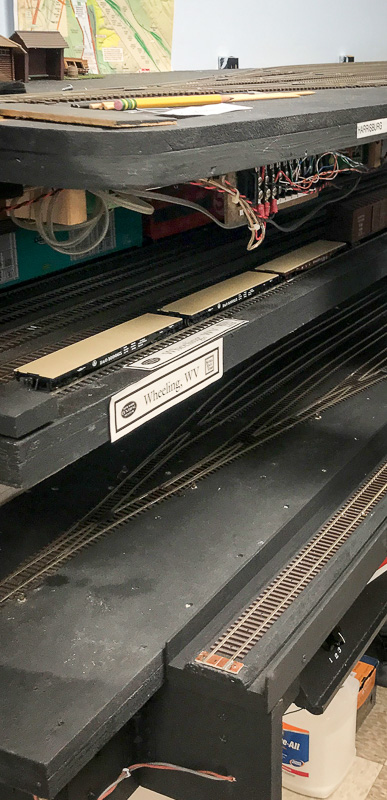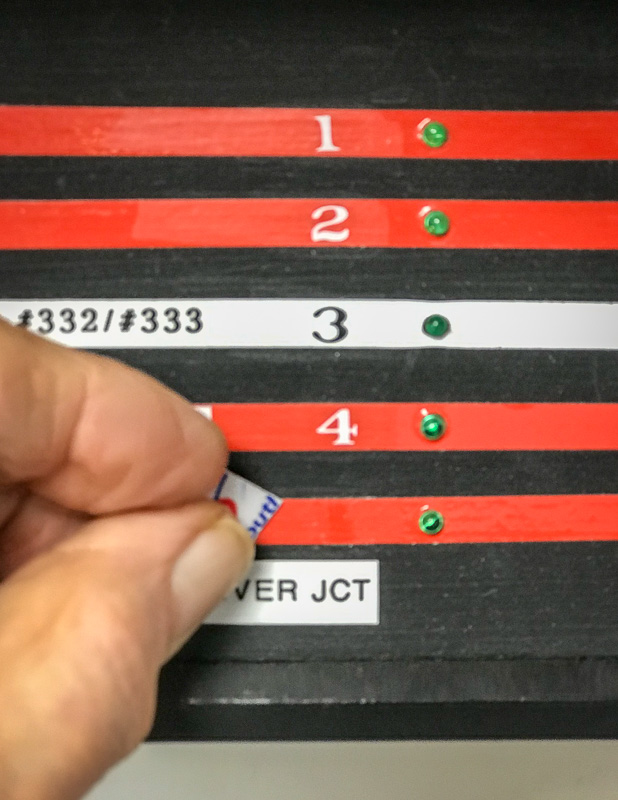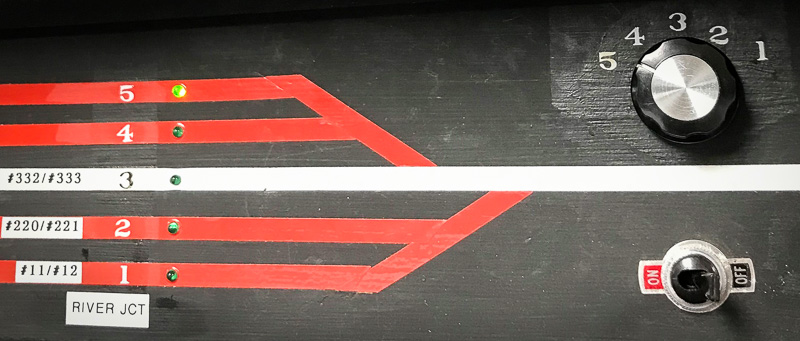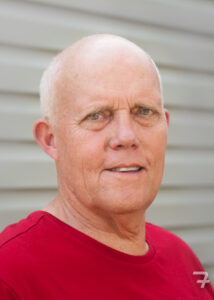
What’s on Your Workbench?
From Don Florwick
Popping into my layout room the other day with no real purpose in mind, I spied a note on one of my staging yard switch panels. The note was reminding me to relabel the panel to clear up an inconsistency between adjacent yard panels.

So why the note? It seems that for some reason unbeknown to me, I labeled this panel for the middle yard, Wheeling Staging, showing yard track #1 on the wall side of the shelf, whereas the other two yards had track #1 as the first track on the aisle side of the shelf. This inconsistency had not caused major problems but it had caused confusion from time to time if an operator failed to look at the yard panel track diagram before picking their track with the rotary switch, hence the note to self to fix it someday.
I try to remove inconsistencies from my railroad’s infrastructure when I see they create confusion. Operators are busy enough minding their schedule and deciding whether they have the authority to make their movement.


Total time to make the change; about two hours of puttering around. Another inconsistency was cleared from the P&SP.
SMD Draft Minutes 13 Dec 2020
Submitted by Clerk Harvey Heyser
Division members met remotely on the internet using the Zoom platform. 18 or so were present. The Superintendent convened the meeting prior to the published start time to allow for any attendees having trouble with the Zoom connection time to try logging in multiple times. After some socializing, Superintendent Jerry Skeim called the business meeting to order shortly after the 2 pm start time.
20.12-1 Paymaster’s Report: Paymaster Ray Price reported that the Division has $3781.32 in its bank account. That amount includes disbursements for the Winter Wheel Report and $16.42 for brochure holders.
In response to questions about NMRA and MER distributions, the Paymaster explained those checks are now sent directly to him (one at the end of August and one in September).
20.12-2 Clerk’s Report (Meeting Minutes): The attendees dispensed with the reading/summary of the minutes (previously distributed by e-mail). Clerk Harvey Heyser read the following clarification received from Web Master Tom Fedor regarding items in the November draft minutes concerning the web site, the blog, and SMD’s Facebook page:
Website/Blog: The Division has one official website. It is smdnmra.org. Our website is the SMD blog. All members should look to smdnmra.org for news, features, and information from Division officials. There could also be news from Region and National officials shared on our blog. I recommend that all SMD members visit frequently, and subscribe to smdnmra.org to receive notifications of official posts on the Division home page.
Facebook Page: The Division also has a social media account on Facebook.com. While the Facebook page is a private site, membership is not restricted to SMD members. If a person demonstrates a genuine interest in our Division or has connections to people in our Division, access to the Facebook content can be granted by the SMD moderators. The Facebook page is a place for those who join to freely share and communicate directly with each other on any topic related to railroading.
To expedite the wording of a somewhat complicated motion, Clerk Heyser made the following motion (seconded by Alex Polimeni):
Motion: That the draft Minutes for the November 2020 meeting be approved as submitted, with the above clarification included in the December minutes. The motion passed unanimously.
WebMaster Fedor’s recommendation that all SMD members join the Division’s Facebook group was also noted.
Old Business:
20.10-4 2021 Mini-Con: In response to questions from attendees, the Superintendent and Chair Pete Clarke repeated the reasons for not holding a Mini-Con in April 2021 (the main reason being the likelihood of being stuck in the pandemic through the spring of 2021). Holding the virtual raffle (see the following minute) will serve to remind area modelers of the future 2022 Mini-Con.
20.10-7 Virtual Raffle: Brian Wolfe has offered to donate a $100 gift card. Bill Martz has forwarded information on what has to be done to conduct a virtual raffle. Bob Morningstar reported there are web sites that can help with the raffle. (He volunteered to help.) The Superintendent will confer with the Advisory Committee and report back in the new year.
20.10-8 Brochures: Bob Johnson reported on the locations he has placed the brochures (Main Line and HobbyTown (and a few more where he plans to place them – the Train Room – Hagerstown – the hobby shop in Mt. Airy, and the Train/Vehicle Museum – Frederick). Members who have other suggestions should contact Bob or Jerry Skeim.
New Business:
20.12-3 Holiday Cards: Alex Polimeni suggested sending actual, USPS-mailed cards to all members as a tangible indication that the SMD is still functioning and that we still value their participation. He shared a link to a card web site and suggested the card of a PRR Altoona to Cumberland train arriving at a depot on a snowy evening in the 1920s (99 cents per card). He indicated that he has the addresses and could get them out quickly. The Superintendent will consider a message insert about SMD activities in the coming year.
Bob Johnson made the following motion (seconded by Ron Polimeni):
Motion: To authorize an expenditure not to exceed $175 for sending holiday cards to the members. The motion passed unanimously.
20.12-4 Staying Engaged: Bob Morningstar suggested bringing projects to the Zoom meetings (making meetings more model-centric) through electronic sharing: using the screen share function of Zoom, short videos (such as Dave Thalman’s layout visit/clinic at the October meeting), and even PowerPoint slide presentations. Members mentioned the Op Sig’s Second Section meetings held each month in addition to their regular meetings and the Hindsight 2020 RPM all-day meet (posted on YouTube). The discussion concluded with a decision to consider additional SMD virtual activities – a second get-together each month (perhaps on a different day of the week).
20.12-5 NMRA Virtual Events: The NMRAx events seem to be organized largely by volunteer effort.
20.12-6 Regional Events: Planning for the in-person fall 2021 MER Convention at Hunt Valley is proceeding. Bob Morningstar cautioned that the event may have to be virtual.
Adjournment: The Superintendent accepted a motion to adjourn. The next meeting will be held remotely in January 2021 (second Sunday at 2 p.m.). Members will be notified by e-mail.
Following the meeting, Bob Morningstar presented a clinic introduction to JMRI, a free tool to aid hobbyists in the enjoyment of all of the sophisticated electronic features of products produced for model railroading. Bob serves as a beta-tester for new versions of JMRI (released at approximately 6-month intervals) and offered to assist SMD members in setting the program up. He also emphasized that JMRI is modular and that you do not have to use all of it.
SMD ZOOM Meeting – 10 Jan., 2 PM

Everyone,
Upcoming Meeting Date: 10 January 2021
The next SMD meeting will take place on Sunday, 10 Jan. 2021 via ZOOM. Log on time opens at 1:30 PM with the business meeting scheduled to start at 2:00 PM. The ZOOM login information is identical to the December meeting. A reminder will be sent out NLT the 9 Jan. 2021.
If any member has any concerns that they feel need to be addressed to the membership, or discussion topics that they feel should be included in the January meeting agenda, please forward them to me through our Gmail address at southmoutaindiv@gmail.com as early as possible before the upcoming meeting.
You will be able to find an impeccably prepared copy of our December meeting minutes at SMDNMRA.org preceding the January meeting.
In other news:
I hope that everyone had a pleasant Christmas. Unfortunately, COVID-19 does not yet seem to be in our rearview mirror and cases continue at very high levels. Here’s hoping that there will not be another post-holiday surge as we witnessed after Thanksgiving. Please continue to follow the guidelines as outlined by our health agencies. On a more positive note, now that a couple of the vaccines have been approved for distribution and once we get the most at-risk populations vaccinated, our health workers, first responder’s and the elderly, I am looking forward to seeing an actual schedule for when the rest of us might be able to get vaccinated.
There is no post-meeting clinic or layout viewing scheduled for this meeting. If anyone would like to share anything with the division at the meeting please let me know through the division email account at southmoutaindiv@gmail.com.
Hope to see you all on Sunday 10 January 2021 at 2:00 PM.
Stay safe and well!
Jerry Skeim, Superintendent
Happy New Year – 2021 Mount Clare Junction

Welcome to 2021! I wish I could say that January 1st completely wipes away 2020, but I can’t. What I can say is that we are continuing to plan a great convention for all of us to get together in 10 month’s time. Expect registration to open in the second quarter with a flurry of announcements before then (you thought I was going to say snow, didn’t you?).
During newsletter signup, and via the website contact page, all are invited to express what you would like to see or do at the convention. If you’ve submitted a request, it’s in the graphic above, and we are actively working to build clinics and events for you.
Should your idea, clinic or interest not be covered by an event listed on the website, take a moment to reach out to us, as other modelers have, and we’ll make something happen!
Share this with your fellow hobbyists.
Stay safe. Wear a mask. Socially distance. Get the vaccine.
Together we can be together in 2021.
[Source Mt. Clare Jct. Convention Committee info@mtclarejct.com -ed]
